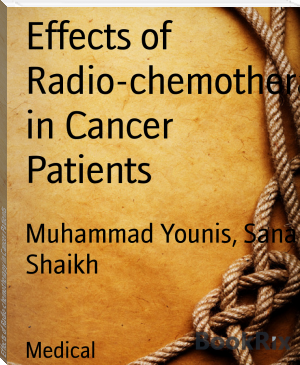Effects of Radio-chemotherapy in Cancer Patients by Muhammad Younis, Sana Shaikh (ereader with android .txt) 📕

- Author: Muhammad Younis, Sana Shaikh
Book online «Effects of Radio-chemotherapy in Cancer Patients by Muhammad Younis, Sana Shaikh (ereader with android .txt) 📕». Author Muhammad Younis, Sana Shaikh
Historically, the three main divisions of radiotherapy are external beam radiotherapy (EBRT or XBRT) or teletherapy, brachytherapy or sealed source radiotherapy, and systemic radioisotope therapy or unsealed source radiotherapy. The differences relate to the position of the radiation source; external is outside the body, brachytherapy uses sealed radioactive sources placed precisely in the area under treatment, and systemic radioisotopes are given by infusion or oral ingestion.[51] The type of radiation to be given depends on the type of cancer, its location, how far into the body the radiation will need to go, the patient's general health and medical history, whether the patient will have other types of cancer treatment, and other factors.[50]
1: External radiation therapy:
External radiation give through external beam radiation.[47] External beam radiation therapy comes from a machine that aims radiation at your cancer. The machine is large and may be noisy. It does not touch you, but rotates around you, sending radiation to your body from many directions.
External beam radiation therapy is a local treatment, meaning that the radiation is aimed only at a specific part of your body. For example, if you have lung cancer, you will get radiation to your chest only and not the rest of your body. [52] External beam therapy is administered just like a normal X-ray. The radiation used for external beam radiation treatments comes from special machines, such as linear accelerators, cobalt machines, or orthovoltage x-ray machines. They deliver intense treatments with pinpoint accuracy. [47]
External beam radiation therapy is the safe delivery of high-energy X-rays to your cancer. [10] External radiation therapy is used to treat most types of cancer, including cancer of the bladder, brain, breast, cervix, larynx, lung, prostate, and vagina. [50]
1. Three-dimensional conformal radiotherapy (3D-CRT) combines multiple radiation treatment fields to deliver precise doses of radiation to the lung tumor.
2: Intensity-modulated radiation therapy (IMRT) is a specialized form of 3D-CRT that modifies the radiation by varying the intensity of each radiation beam. [53]
3: Stereotactic Radiotherapy is a type of external beam radiotherapy that focuses high doses of radiation within the body, and claims to be much more accurate than other methods of radiation therapy. Cyberknife, Gamma Knife, and Novalis Tx are three current technologies.[16]
4: Prophylactic cranial irradiation (PCI) is an external radiation given to the brain when primary cancer (for example, small cell lung cancer) has a high risk of spreading to the brain.
5: Intraoperative radiation therapy (IORT) is a form of external radiation that is given during surgery. IORT is used to treat localized cancers that cannot be completely removed or that have a high risk of recurring (coming back) in nearby tissues. [50]
Sources of external radiation:
1: Gamma rays (denoted as γ) are electromagnetic radiation of high energy (very short wavelength).Gamma-rays can kill living cells, a fact which medicine uses to its advantage, using gamma-rays to kill cancerous cells. Despite their cancer-causing properties, gamma rays are also used to treat some types of cancer. In the procedure called gamma-knife surgery, multiple concentrated beams of gamma rays are directed on the growth in order to kill the cancerous cells. The beams are aimed at different angles to concentrate the radiation on the growth while minimizing damage to the surrounding tissues. [54]
2: X-rays are created by machines called linear accelerators. Depending on the amount of energy the x-rays have, they can be used to destroy cancer cells on the surface of the body (lower energy) or deeper into tissues and organs (higher energy). Compared with other types of radiation, x-rays can deliver radiation to a relatively large area.
3: Particle beams use fast-moving subatomic particles instead of photons. This type of radiation may be called particle beam radiation therapy or particulate radiation. Particle beams are created by accelerators. Unlike x-rays and gamma rays, some particle beams can penetrate only a short distance into the tissue. Therefore, they are often used to treat cancers located on the surface of or just below the skin.
4: Proton beam therapy is a type of particle beam radiation therapy. Proton beam therapy is also being used in clinical trials for intraocular melanoma (melanoma that begins in the eye), retinoblastoma (an eye cancer that most often occurs in children under age 5), rhabdomyosarcoma (a tumor of the muscle tissue), some cancers of the head and neck, and cancers of the prostate, brain, and lung.[50]
2: Internal radiation therapy Or Brachytherapy: Uses radiation that is placed very close to or inside the tumor. The radiation source is usually sealed in a smallholder called an implant. Implants may be in the form of thin wires, plastic tubes called catheters, ribbons, capsules, or seeds. The implant is put directly into the body. Internal radiation therapy may require a hospital stay. Internal radiation therapy involves placing radioactive substances such as cesium, iridium, and iodine near or into cancerous cells within the body.
Internal radiation is usually delivered in one of two ways, each of which is described below. Both methods use sealed implants. [47][50]
1: Interstitial radiation therapy is inserted into the tissue at or near the tumor site. It is used to treat tumors of the head and neck, prostate, cervix, ovary, breast, and perianal and pelvic regions.
2:Intracavitary or intraluminal radiation therapy is inserted into the body with an applicator. It is commonly used in the treatment of uterine cancer. Researchers are also studying these types of internal radiation therapy for other cancers, including breast, bronchial, cervical, gallbladder, oral, rectal, tracheal, uterine, and vaginal.
3: Systemic radiation therapy uses radioactive materials such as iodine 131 and strontium 89. The materials may be taken by mouth or injected into the body. [47]
Sources of internal radiation therapy:
The energy (source of radiation) used in internal radiation comes from the radioactive isotope in radioactive iodine (iodine 125 or iodine 131), and from strontium 89, phosphorous, palladium, cesium, iridium, phosphate, or cobalt. Other sources are being investigated. [47][50]
1.9. Biological effect of radiation on cancer tissue: Direct effect:
The radiations damages DNA molecules. No effects are visible immediately. But the damage is observed during the next mitosis. Since new DNA can not be synthesized, cells die at the attempt of the next division, chromosome breakage is often noticed.
Indirect effect: Damage to local blood supply cuts off the nutrition and causes local necrosis and cell death. Partially damaged cells are also destroyed by the immunologically systems. [55]
Effect of radiation therapy on blood cells:
Bone marrow and lymphoid tissues are highly radio-sensitive because of the higher rate of cell division on these organs. Leukopenia and thrombocytopenia is an accepted side effect of radiotherapy. A periodic check of blood counts is down during radiotherapy, and if the blood count is drastically lowered, [WBCs count below 2,000/cu mm and platelets count below 80,000], the therapy is temporarily stopped till recovery is affected. [16] The destruction of the highly radiosensitive lymphocytes by radiotherapy could decrease the cell-mediated response to cancer and increased metastases. [56]
Side effects of radiotherapy:
Side effects are different for everyone. Some patients feel fine during treatment while others may feel uncomfortable. [53] Side effects vary among treatment plans. Only a physician will be able to provide side effects expectations because it really does vary among treatment. [57]
The side effects depend on how much of your brain is being treated or if the spinal canal has to be treated as well. Most side effects are quite mild and all efforts are made to minimize them. However, some are inevitable. [49]
Early side-effects:
Hair loss: You will lose your hair in the area irradiated. Hair starts to fall out between the second and third weeks of treatment and will usually have grown back to its maximum extent by 3-6 months Skin changes: You may notice some skin changes in the area being treated. After about 3 weeks it may redden and become itchy and darkened, as sunburn does.[49][53] Tiredness: Most people will feel tired and a little sleepy towards the end of their course of radiotherapy.[49] Nausea: Very rarely people feel sick.[49][53] Weight: You may find that your weight has increased, especially if you have been on steroid tablets.[49] Blood count: Cancer-related causes of low blood cell counts.[49,58]Later side-effects:
There are some side-effects that can develop many months or years after radiotherapy. If, the pituitary gland or the hypothalamus receives a high radiotherapy dose, regulation of some of the hormones can be upset. This may lead to a loss of periods, or sexual function and sometimes an underactive thyroid. However, all of these can be treated by hormone replacements. Most people are concerned about the effect of radiotherapy on their intelligence. [59]
CHEMOTHERAPY




Comments (0)